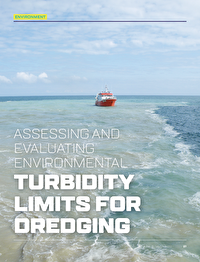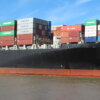Introduction
Excessive suspended sediment concentration has an impact on water transparency – as a result of increased turbidity – and may cause the degradation of water quality and marine ecosystems.
Mitigating the impacts of turbidity is usually managed by limiting the amount of suspended sediments released at the dredging sites or entering sensitive areas. For dredging projects around the world, many different limit definitions and corresponding turbidity monitoring methods have been applied. However, the basis or background of these definitions is not always clear. Sometimes a very strict or alternatively very ambiguous definition of the turbidity limits can have a serious impact on the project execution methodology proposed by bidding contractors and thus on their quoted price. A very loose definition of the turbidity limits can additionally have a huge impact on the local environment. In many cases, turbidity limits may even appear to be defined without consideration of the specific sensitive receptors that are supposed to be protected. One potential risk that may result is that on the one hand, the turbidity limits may be overly conservative, while on the other hand, they may also be inadequate in protecting the sensitive receptors.
In 2016, the CEDA Environment Commission (CEC) conducted a survey among a wide range of companies and institutes working with dredging to investigate which environmental turbidity limits existed for dredging projects, how these limits were set and how the environmental limits affected the projects both financially and time-wise. Interestingly, the survey showed that compliance monitoring on average contributed about 1–5% to the cost of the dredging project.
The majority of the respondents indicated that they understood and supported the need for environmental turbidity limits. However, the replies also showed that a major proportion of the limits did not seem to be scientifically or environmentally founded. Limits varied regionally and by project but rarely seemed to be linked to local sensitive receptors. Taking into account the generally high costs of compliance monitoring and the environmental risk that a limit is set incorrectly, the CEC raised the following question: Is there a need for guidelines on how to set realistic and effective environmental turbidity limits for dredging?
The results of the questionnaire imply that there is such a need. However, setting a reasonable turbidity limit for a given dredging operation that provides adequate protection for the environment, but that gives sufficient flexibility in the selection of a dredging approach and does not entail excessive costs for monitoring the dredging operation, is not an easy task. It requires an understanding of the dredging operation and dredging spill processes as well as how the local environment works in terms of hydrodynamics, sediments and biology. Furthermore, it is necessary to consider socioeconomic aspects such as visual disturbances and impacts on water intakes.
The article aims to highlight a general approach to set or discuss turbidity limits for dredging applications. Connections to background information, monitoring and management measures (as relevant where exceedance occurs) are provided.
Approach
This article is based on the assumption that setting turbidity limits requires a general understanding of dredging processes as well as the surrounding environment. The approach is thus an integrated approach that takes all aspects into account. The main required aspects for a general integrated approach are:
- An understanding of the baseline conditions for hydrodynamics, sediments and biology;
- An understanding of the dredging operations in terms of locations, volumes and spills;
- An understanding of the sensitive receptors and their tolerance levels;
- An understanding of possible monitoring programmes; and
- An understanding of possible response options.
To implement this approach, a typical flowchart for managing environmental turbidity limits in a dredging operation is shown. In this figure, the different parts of the flowchart and the interactions between them are highlighted (see figure 1). This flowchart will form the basis of this article.






















